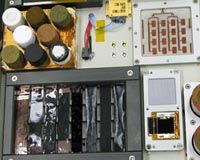 |
Argonne, Ill. (UPI) Dec 10, 2009 U.S. scientists say they are seeking a way of controlling the Casimir force -- a quantum mechanical force that hampers creation of nanoscale machines. Researchers at the Department of Energy's Argonne National Laboratory said the Casimir force, which attracts objects when they are only 100 nanometers apart, is so small most experimentation has only dealt with its characteristics. "If we can control this force or make it repulsive, it can have dramatic effects on the development of nanoelectromechanical systems," said Derrick Mancini, interim director of the Argonne Center for Nanoscale Materials. The researchers said nanoelectromechanical systems, usually referred to as NEMS, are nanometer size mechanical devices that can be used for actuation or sensing at the nanoscale. In the macro world, the Casimir force is so small it can be barely detected, the scientists said. But at the nanoscale it becomes a quantum effect that scientists cannot currently control. "As characteristic device dimensions shrink to the nanoscale, the effects of the attractive Casimir force becomes more pronounced, making very difficult to control nanodevices," said Argonne scientist Daniel Lopez. "This is a technological challenge that (needs) to be addressed before the full potential of NEMS devices can be demonstrated." Officials said the project will include researchers from Argonne, Indiana University, Purdue University, the National Institute of Standards and Technology and the Los Alamos National Laboratory. Share This Article With Planet Earth
Related Links Nano Technology News From SpaceMart.com Computer Chip Architecture, Technology and Manufacture
 Nanotech Experiment To Weather The Trials Of Orbit
Nanotech Experiment To Weather The Trials Of OrbitTroy NY (SPX) Nov 18, 2009 Novel nanomaterials developed at Rensselaer Polytechnic Institute are scheduled to blast off into orbit on November 16 aboard Space Shuttle Atlantis. The project, funded by the U.S. Air Force Multi University Research Initiative (MURI), seeks to test the performance of the new nanocomposites in orbit. Space Shuttle Atlantis will carry the samples to the International Space Station (ISS). T ... read more |
|
| The content herein, unless otherwise known to be public domain, are Copyright 1995-2009 - SpaceDaily. AFP and UPI Wire Stories are copyright Agence France-Presse and United Press International. ESA Portal Reports are copyright European Space Agency. All NASA sourced material is public domain. Additional copyrights may apply in whole or part to other bona fide parties. Advertising does not imply endorsement,agreement or approval of any opinions, statements or information provided by SpaceDaily on any Web page published or hosted by SpaceDaily. Privacy Statement |